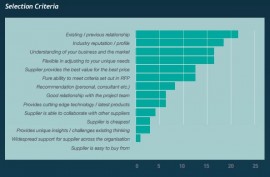Fintech investment switches to smaller projects
The research report, How to influence FinTech buyers in capital markets, found that 63% of respondents reported their technology projects over the last year have cost less than $500K, with 45% having a CAPEX of less than $250K. The study also found that 43% of this investment had been made in infrastructure and analytics technology. As expected, regulation is a big driver for investment with 37% of investments in the last year attributed to regulatory demands or technology advances.
One of the primary investments has been in moving towards cloud services, particularly in areas such as HR and communications. Aite Group predicts capital markets spending on cloud services to increase from $2.5bn in 2014 to $3.2bn in 2017.
In terms of what factors influence decision making, the report notes that buyers look for evidence that a vendors’ reputation is deserved and at their ability to challenge existing thinking. Here, as well as peer recommendation, buyers look to consultants and analysts as well as vendor case studies and presentations. When it comes to sealing the deal, aside from having an existing relationship with the vendor, buyers again go back to reputation. They also want to feel confident that the vendor knows their business and the market and is reliable.
“The buying and influencer landscape in capital markets is a dichotomy. Capital markets firms are forward thinking in terms of eschewing major technology investments, to focus on CAPEX-light projects. In contrast, traditional influencing factors such as relationships, reputation and profile make the difference when a buyer is selecting a vendor,” said Imran Majid, deputy head of FinTech, CCgroup. “This contrast highlights the need for insight to inform the strategy of sales and marketing teams. With better intelligence, FinTech companies can stand out from the pack and gain a bigger slice of the market.”
The report was based on interviews with senior decision makers at capital markets firms regarding what influences their selection of technology vendor at different stages of the purchasing process. In total, 55% of respondents were from the buy-side and 45% from the sell-side. 75% were either C-Suite, board member, head of department, president or VP.












































